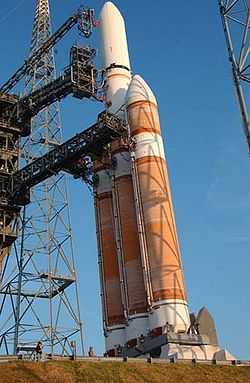Modular rocket

A modular rocket is a type of multistage rocket which features components that can be interchanged for specific mission requirements. Several such rockets use similar concepts such as unified modules to minimize expenses on manufacturing, transportation and for optimization of support infrastructure for flight preparations.
Examples
Atlas V
The Atlas V expendable launch system uses the liquid fueled Common Core Booster as its first stage. In most configurations a single CCB is used with strap-on solid rocket boosters. A proposed configuration for heavier loads strapped together three CCBs for the first stage. The Common Core Booster utilizes the Russian made RD-180 burning RP-1 fuel with liquid oxygen producing a thrust of 3.8 MN. The liquid propellant tanks use an isogrid design for strength, replacing previous Atlas tank designs which were pressure stabilized.[1]
The length of the common core booster is 89 feet (27 m), and has a diameter of 12.5 feet (3.8 m).[2]
Delta IV
The Delta IV launcher family uses the liquid fuel Common Booster Core as the first stage of the various rocket configurations. One or three modules can be used as the first stage. In most configurations a single CBC is used with or without strap-on SRBs. Three CBCs together form the first stage of the Heavy configuration. The CBC uses the Rocketdyne RS-68 engine and burns liquid hydrogen with liquid oxygen producing a thrust of 2.9 meganewtons (650,000 lbf).
Angara
The Universal Rocket Module (URM) is the modular liquid fueled first stage of the Angara expendable launch system. Depending on the configuration, the first stage can consist of 1, 3, 5 or 7 URMs. Each URM uses a Russian-made RD-191 engine burning RP-1 fuel with liquid oxygen producing a thrust of 1.92 MN.[3]
Falcon Heavy
The Falcon Heavy launch vehicle consists of a standard Falcon 9 v1.1 center core with two additional Falcon 9 v1.1 stretched core stages acting as liquid strap-on boosters. Each core is powered by 9 Merlin 1D engines burning rocket-grade kerosene fuel with liquid oxygen producing almost 5.6 meganewtons (1,300,000 lbf) of thrust. Falcon Heavy is being designed with a unique propellant crossfeed capability, where fuel and oxidizer is fed to power most of the engines on the center core from the two side cores, up until the side cores are near empty and ready for the first separation event.[4]
All three booster cores are planned to eventually be reusable.[5] After the side cores are released, the center engine in each side core will continue to burn for a few seconds in order to control the trajectory of the side boosters.[6]
See also
- Evolved Expendable Launch Vehicle
- Liquid Rocket Booster
- History: UR-700[7]
External links
- EELV: The Next Stage of Space Launch
- Angara page by Khrunichev Space Center (Russian)
- Angara page on RussianSpaceWeb
References
- ↑ Launch Vehicles, Lockheed Martin
- ↑ Lockheed Martin Names New Rocket Atlas V, Lockheed Martin
- ↑ Rocket family «Angara», Khrunichev State Research and Production Space Center
- ↑ Strickland, John K., Jr. (September 2011). "The SpaceX Falcon Heavy Booster". National Space Society. Retrieved 2012-11-24.
- ↑ Simberg, Rand (2012-02-08). "Elon Musk on SpaceX’s Reusable Rocket Plans". Popular Mechanics. Retrieved 2012-02-07.
- ↑ Nield, George C. (April 2014). Draft Environmental Impact Statement: SpaceX Texas Launch Site (Report) 1. Federal Aviation Administration, Office of Commercial Space Transportation ". p. 2-3.
The center core engines are throttled down after liftoff and up to two engines may be shut down as the vehicle approaches maximum acceleration. After the side boosters drop off, the center core engines throttle back up to full thrust. The center engine in each side core continues to burn for a few seconds after separation to control the trajectory of the side booster.
- ↑ Universal Rocket series was a soviet project of unified rocket systems (military & civilian), UR-700 project was supposed to use liquid fuel boosters with similar design to its first stage.